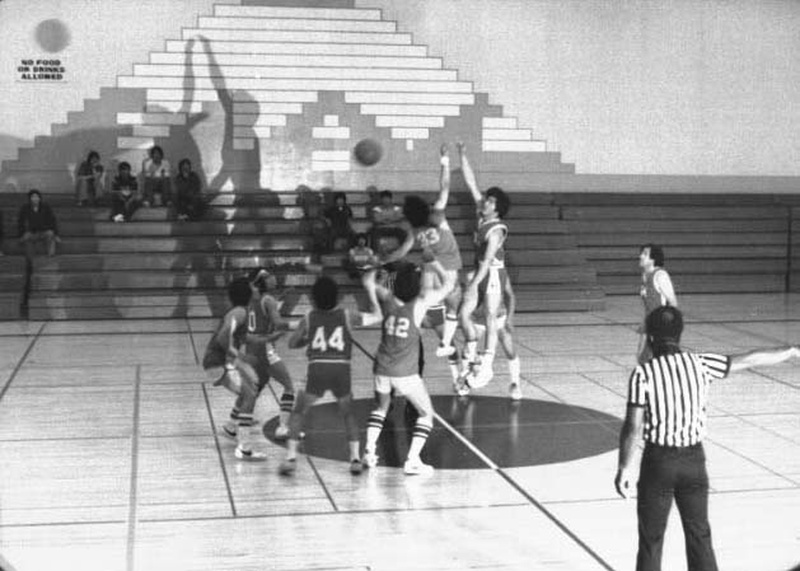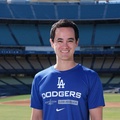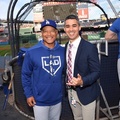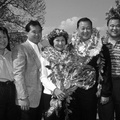When I was five years old, our family lived in Los Angeles on 12th Avenue, near what was known as the Seinan district. Construction of the Santa Monica Freeway was being planned, and its path went right through our home. Because of this our house was condemned, and our family moved to an unincorporated area of the San Gabriel Valley which became Temple City. At that time there were a lot of dairies and chicken farms there, but few sidewalks. And almost no other Japanese Americans. When my oldest brother graduated from Temple City High School, he was the first Nikkei to do so. When my sister graduated, she was the second.
Our lives were indicative of a growing trend in the 1950s and 1960s which saw Southern California Japanese Americans moving away from each other. Our family still belonged to Centenary United Methodist Church located in our old neighborhood, but we attended less and less as the years went by. My brothers and I were members of different YMCA clubs through the church, all filled with Japanese American boys. The clubs played sports, went to summer camp, and met on Friday nights at the church. I was a member of the Comets, whose members were the only Nikkei boys I knew my own age. Despite the fact my uncle, Akira Komai, was the publisher of The Rafu Shimpo, the largest Japanese–English language newspaper on the mainland, our family seemed fairly distant from the Southern California Japanese American community.
Things changed when I turned 19. My cousin Michael had a team in the Southern California Nisei Athletic Union (NAU) basketball leagues. These leagues were created after World War II to give Japanese American men a place to play basketball. In addition to the fact that Japanese Americans weren’t welcome in many other open leagues, organizers liked the idea of a community league. My cousin often stayed with my family when we vacationed at a rented cottage in Newport Beach. One summer we were shooting baskets, and he and his brother-in-law wondered if I would be interested in playing. The next summer, I played my first NAU game at Westchester High School. We wore blue T-shirts as uniforms and I played in old Converse shoes that didn’t fit me properly.
I was a terrible player. I fouled out of almost every game and barely got any minutes. I don’t think I scored. We lost the first seven games I played, after the team had won the first two without me. And yet this was the beginning of my almost 30 years of participation in an adult community league. Through many hours of playing, practicing, and learning, I got better. And our teams eventually became more competitive.
What I enjoy about community basketball is that in the gym, on the court, it doesn’t matter if you’re rich or poor, a Ph.D. or a high-school dropout, Buddhist or Christian—the team that plays better wins. Your performance on the court is entirely predicated on your ability and knowledge. Family connections and fancy cars don’t mean anything compared to foot speed and fall-away jump shots. There are many people in the leagues who I have known for decades, known them to be good-natured, intelligent, and generous, and yet I have no idea what they do for a living. In a sense, it’s irrelevant. Leave it at the gym door.
I started out wanting merely to play basketball, but I am the beneficiary of many long relationships with other Japanese Americans whom I’ve gotten to know through the Nikkei leagues. In addition to playing, I began working as a scorekeeper at men and women’s games. Eventually, I started coaching. And I wound up on the board of commissioners for the NAU. I also began working for my uncle at the newspaper. But my relationship to the basketball leagues is probably more indicative of one of the last strong connections to the Nikkei community by individuals of my generation.
If anything demonstrates the unpredictability of life, it is the remarkable phenomenon of the sport of basketball—especially youth basketball—becoming the unifying force in Japanese American communities in California in the 1990s. Basketball is not the sport one historically associates with Japanese Americans. Baseball, swimming, the martial arts, bowling, golf—all these have historic and/or cultural ties. Basketball, as a rule, favors the tall and strong (although former Marquette University coach Al McGuire observed that anyone who is quick can play basketball). In America in the last three decades, basketball has become more of a game played and perfected on city playgrounds while the Nikkei middle class largely has moved to the suburbs.
However, the growth in participation by both Japanese American adults and youth, male and female, would stun anyone familiar with the immediate postwar Nikkei community. Today, adults play well into their fifties and even sixties. Children begin practicing in an organized fashion when they are four or five years of age. During a stretch of time from March through Memorial Day each year, it is possible for youth teams to play almost every weekend in tournaments held in Los Angeles, San Jose, Sacramento, and San Francisco. The Tigers Youth Club Scholarship Invitational Basketball Tournament hosted more than 400 men’s, women’s, boys’, and girls’ teams in Southern California over Memorial Day weekend in 1999.
This impressive participation level comes despite serious obstacles. Unlike 50 years ago when Japanese Americans mostly lived in enclaves, Nikkei families are scattered throughout Southern California, so neighborhood teams do not form naturally. Serious effort must be exerted to locate a sufficient number of youngsters to form a youth team. Any family with more than one child participating must maneuver around multiple schedules of practices and games. And unlike when I was young, basketball is played all year round. But it is striking to see the strength of the commitment by the players’ parents. Much of it stems from a desire by the parents to have their children associate with other Nikkei their own age. Also, it allows the parents to remain in contact with their Japanese American friends, especially if they have children the same ages. And, perhaps, it is the absence of other Nikkei community-wide activities that cut across religious, economic, and social boundaries which makes basketball the first and sometimes only choice for Japanese American involvement for these families.
Youth basketball, as constituted in the Japanese American community, has some advantages over other sports. All the youth leagues use a running clock that stops only in the final two minutes of the contest. This means that most games (with the exception of overtime contests) are played within an hour. It can be practiced or played indoors, which means it can be done day or night, all year round. And it means spectators don’t have to sit outside in the elements.
I believe that certain elements inherent in youth basketball jibe with Japanese American values. From my observations, Japanese Americans as a community often promote the group over the individual, praise hard work and self-sacrifice, and emphasize, in the abstract, the ideal that doing one’s best is more important than success (winning). Many of these values conflict directly with the desire to win, even in the youngest age divisions. On the one hand, the group value says that everyone on the team should be allowed to play, regardless of ability. On the other, competitive zeal creates the temptation to play those with the most talent as much as possible and limit the less competent players to token appearances. This is a scenario played out consistently in Little League, Pop Warner, and any youth sports league you can name.
This dilemma is often handled by creating even more pressure to do well. For example, a coach starts the game using his more talented players with the goal of providing an enormous lead for the team. This would allow the lesser-talented players plenty of court time since the victory was assured. Obviously, this scenario only works for the best youth teams.
The other teams were bolstered by another belief—the idea that five less-talented players working together could defeat an opponent with superior ability. It is a tempting model for those wanting to promote a group mentality. In a sense, this is a useful myth, a variation on the David-and-Goliath story. Because upsets are memorable and stay in our minds, it is easy to invoke them. We tend to forget all the other games because they are the norm. I have played organized basketball most of my life, beginning with the YMCA and as an adult in the Japanese American leagues. I have played in, coached in, kept score for, and just plain observed thousands of Nikkei community games in four decades. From what I have seen at this level, the team with the superior talent wins about 90 percent of the time (and that’s a conservative estimate). If the teams have comparable talent, anything can happen, but if one team has obviously superior ability, they will win.
When you are trying to get young people to behave in a certain manner, however, it is useful to take advantage of their competitive desires by pointing toward singular and memorable examples of success which promote that sort of behavior. The surface goal promoted is winning, but, there is an underlying value system being drummed into young people who play in these youth leagues. Even if parents are not particularly sports fans, they may want their children to be part of this process, an indoctrination not necessarily available in other areas of their lives.
Another reason for the popularity of the youth leagues, I believe, is that so many of the players’ parents participated as youngsters and adults. Because of this, many of their individual relationships with other Japanese Americans are products of their participation in these organized leagues. Not surprisingly, like most parents, they want to give their children the opportunity to be involved in something they themselves enjoyed as youngsters.
In a sense, this sentiment has been around for generations in the Japanese American community. Organized basketball has been a part of the community since before World War II. Its post-war resurrection in Southern California coincided with the revival of The Rafu Shimpo. In 1946, as Japanese Americans began returning to Los Angeles from government-forced incarceration, voluntarily relocation, and/or military service, my Uncle Akira restarted the Rafu. My grandfather Toyosaku was the prewar publisher, but the FBI took him away on December 7, 1941, and held him until 1946, well after the war ended.
My uncle was the oldest son and he was left with the responsibility of running the newspaper for a community that the U.S. government wanted to disband. When it was clear that the U.S. government would force all Japanese Americans off the West Coast, my uncle was determined to save the newspaper. He hid the Japanese metal type and waited for the opportunity to return to Los Angeles. Thanks to the loyalty of prewar employees who returned to work even though my uncle had no money, Akira was able to restart the newspaper in 1946. But, given the conditions in the Japanese American community at that time, good news was hard to come by. Housing was an enormous problem. Jobs were elusive. And overt prejudice often manifested itself in physical attacks and confrontations.
Seeking ways to improve community morale as well as creating a steady source of news, my uncle used a prewar model as his guide. Before the war, an organization called the Japanese Athletic Union (JAU) was the hub of sport in the Southern California community. Mas Satow was the key figure in JAU, whose activities were reported in the Rafu. I believe that my uncle thought the creation of a successor to JAU would be beneficial to the community and the newspaper.
In 1946, columnist Paul Uyemura publicly urged the formation of a new sports organization. He noted that an organization was needed to settle disputes, set rules, and acquire the use of gymnasiums and assign game officials. By the end of 1946, the Nisei Athletic Union was formed, with a Board of Control to administrate a basketball league, including laying out rules and procedures. Five people were on the original board (my uncle was conspicuously absent—he preferred working behind the scenes and hated to be in the spotlight) including Yuichi Hirata, Yoshio Kodama, Dave Nakagawa, Paul Uyemura, and Harry Honda. Hide Kunitomi was the NAU Basketball Association President.
Honda was the long-time editor of the Japanese American Citizens League newspaper, The Pacific Citizen. He was a college student at the time of NAU’s formation. Although Akira Komai was not listed as an official of the NAU, according to Honda he was the driving force behind its establishment. It’s notable that most of the NAU’s first meetings were held at the offices of the Rafu, confirming my uncle’s close involvement.
It’s also important to note that a Northern California NAU was founded at the same time, and both organizations collaborated to have their respective basketball champions compete in a state title game that first year. These state championships continue to this day in four skill divisions. My uncle, in his column “Dis ‘N Dat!” (which he wrote under the pen name, “The Maestro”), observed that Japanese American basketball leagues already had been formed in New York and Chicago with strong possibilities in Denver and Salt Lake City, showing the widespread interest in organized Nikkei basketball.
*This article was originally published in More Than A Game: Sport in the Japanese American Community (2000).
© 2000 The Japanese American National Museum






